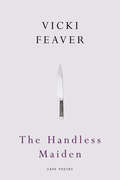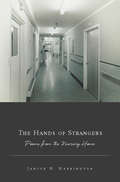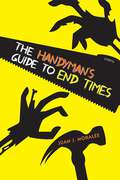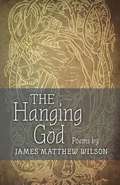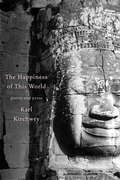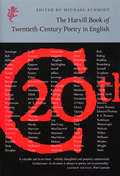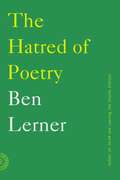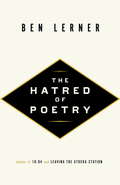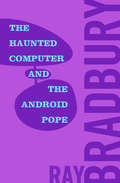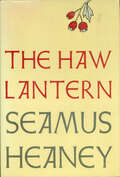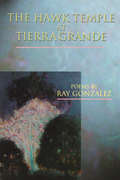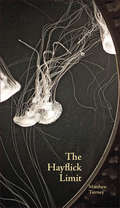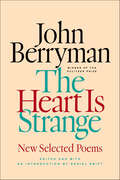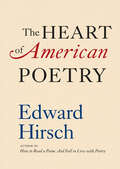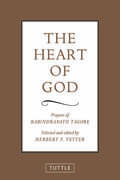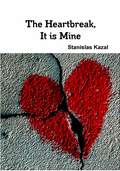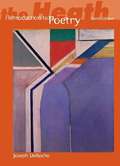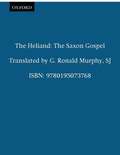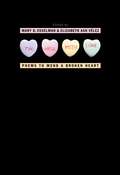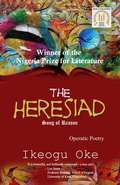- Table View
- List View
The Handless Maiden
by Vicki FeaverThe poems in this extraordinary book deal in familiar emotions - love, grief, rage, loneliness - but do so with such a fresh and fierce eye, such lived intensity, that the familiar is given again the force to touch our nerves, to seem raw and new. Some of the poems are based in the territory of home and childhood, others move into that unnerving space where the safe and polite world plunges over a ledge - into anarchic revisions of what is possible or acceptable. They treat myths and fairy stories, or even paintings, not as fictions but as part of our continuing experience. Powerful and sensuous, wry and witty, their clear voice stays in the mind: provoking, questioning, refusing to accept the soft lie. These disturbing and passionate poems demand to be read.
The Hands of Strangers
by Janice N. HarringtonAs people live longer, we face the challenges that come with caring for, and living as, an aging population. This collection focuses on the sad, funny, mundane reality of life in a nursing home. In her own words, Janice N. Harrington worked her way through college as a nurses' aide and wrote The Hands of Strangers because she "cannot forget the 'girls' I worked with or the 'residents' under my care. I haven't forgotten what I saw, heard, felt, or learned." Janic N. Harrington's debut Even the Hollow My Body Made is Gone earned teh 2007 Kate Tufts Discovery Award, the A. Poulin Jr. Poetry Prize, and an NEA fellowship for poetry.
The Hands of Strangers: Poems from the Nursing Home (American Poets Continuum)
by Janice N. HarringtonAs people live longer, we face the challenges that come with caring for, and living as, an aging population. This collection focuses on the sad, funny, mundane reality of life in a nursing home. In her own words, Janice N. Harrington worked her way through college as a nurses' aide and wrote The Hands of Strangers because she "cannot forget the 'girls' I worked with or the 'residents' under my care. I haven't forgotten what I saw, heard, felt, or learned." Janic N. Harrington's debut Even the Hollow My Body Made is Gone earned teh 2007 Kate Tufts Discovery Award, the A. Poulin Jr. Poetry Prize, and an NEA fellowship for poetry.
The Handyman's Guide to End Times: Poems (Mary Burritt Christiansen Poetry Series)
by Juan J. MoralesIn Morales&’s newest collection, an imagined zombie apocalypse intertwines with personal narrative. From zombie dating to the sin of popcorn ceilings, these poems investigate the nature of impermanence while celebrating the complexities of life.
The Hanging God
by James Matthew WilsonIn The Hanging God, James Matthew Wilson mines the landscape of contemporary American life for images to reflect its moral ravages. Raw in their affective power, Wilson's narratives avoid ambiguity in matters of faith without sacrificing complexity of feeling, compassion, and self-examination. Strippers, divorcees, corporate accountants move among dumpsters, barrooms, bedfellows, beer bottles, and Excel spreadsheets, while the poet examines our confused postmodern responses to these tragicomic figures: would I 'weep or smile' at their worldly losses?
The Happiness of this World
by Karl KirchweyIt is this "shockability" that informs Karl Kirchwey's new work. Through four collections, he has explored the resonances between past and present, seeking a sense of home in a world of losses. Now, as the horrors of the modern world crowd in on him, he meditates on the future his children will inherit. These are angry poems, tender poems, poems of hope, love, and despair. Reviewing Kirchwey's last book in The New Criterion, William Logan wrote: "An elegy for an uncle, a World War II pilot killed in the Pacific, reminds us that we live only by the sacrifice of the dead, and therefore in their shadows. Shadows fall frequently over these poems, from lives corrupted, crippled, or destroyed," and in the concluding section of this new work, a prose memoir with poems that will appear in full in Parnassus, the poet revisits that dead uncle and the unhappy generations preceding his own. Seeking out family origins and family secrets, this section climaxes in a holy Hindu pilgrimage in honor of the dead and returns the poet, who in his search has circled the globe, to the family of the living and the circumscribed happiness of this world.
The Happiness of this World
by Karl KirchweyIt is this "shockability" that informs Karl Kirchwey's new work. Through four collections, he has explored the resonances between past and present, seeking a sense of home in a world of losses. Now, as the horrors of the modern world crowd in on him, he meditates on the future his children will inherit. These are angry poems, tender poems, poems of hope, love, and despair. Reviewing Kirchwey's last book in The New Criterion, William Logan wrote: "An elegy for an uncle, a World War II pilot killed in the Pacific, reminds us that we live only by the sacrifice of the dead, and therefore in their shadows. Shadows fall frequently over these poems, from lives corrupted, crippled, or destroyed," and in the concluding section of this new work, a prose memoir with poems that will appear in full in Parnassus, the poet revisits that dead uncle and the unhappy generations preceding his own. Seeking out family origins and family secrets, this section climaxes in a holy Hindu pilgrimage in honor of the dead and returns the poet, who in his search has circled the globe, to the family of the living and the circumscribed happiness of this world.
The Harvill Book of 20th Century Poetry in English
by Michael SchmidtMichael Schmidt’s anthology includes the work of more than a hundred poets from every part of the English-speaking world. What links their diverse voices is a common language: each poem, in its own way, adds to the resources of the medium and makes it new.The poems in this book are allowed to slip free of their moorings in the biography and history of the last century to create new spaces and times. They have been chosen because they are exceptional, profound and unique in what they do to language, regardless of their subject matter or the orientation of the poet. It is a powerful reminder that in the twentieth century poems did what they have never done before, and it provides us with a unique insight into the forces that will shape the poetry of the twenty-first century.
The Hatred Of Poetry
by Ben LernerNo art has been denounced as often as poetry. It's even bemoaned by poets: "I, too, dislike it," wrote Marianne Moore. "Many more people agree they hate poetry," Ben Lerner writes, "than can agree what poetry is. I, too, dislike it and have largely organized my life around it and do not experience that as a contradiction because poetry and the hatred of poetry are inextricable in ways it is my purpose to explore." In this inventive and lucid essay, Lerner takes the hatred of poetry as the starting point of his defense of the art. He examines poetry's greatest haters (beginning with Plato's famous claim that an ideal city had no place for poets, who would only corrupt and mislead the young) and both its greatest and worst practitioners, providing inspired close readings of Keats, Dickinson, McGonagall, Whitman, and others. Throughout, he attempts to explain the noble failure at the heart of every truly great and truly horrible poem: the impulse to launch the experience of an individual into a timeless communal existence. In The Hatred of Poetry, Lerner has crafted an entertaining, personal, and entirely original examination of a vocation no less essential for being impossible.
The Hatred of Poetry
by Ben LernerNovelist and poet Ben Lerner argues that our hatred of poetry is ultimately a sign of its continued relevance.Poetry. Perhaps Marianne Moore said it best: "I, too, dislike it." What other art takes its marginality as a given, and is so widely bemoaned even by its practitioners? Ben Lerner writes, "Many more people agree they hate poetry than can agree what poetry is. I, too, dislike it and have largely organized my life around it and do not experience that as a contradiction because poetry and the hatred of poetry are inextricable in ways it is my purpose to explore."In this inventive and plain-spoken essay, Lerner takes the hatred of poetry as the starting point of his defence of the art. He examines both poetry's greatest haters (beginning with Plato, who famously claimed that an ideal city had no place for poets, who would only corrupt and mislead the young) and its greatest practitioners, providing inspired close-readings of Keats, Dickinson, Whitman, and others. Throughout, he attempts to explain the noble failure at the heart of every poem: the impulse to launch the experience of an individual into a timeless, communal existence. In The Hatred of Poetry, Lerner has crafted an entertaining, personal, and entirely original examination of a vocation no less essential for being impossible.
The Haunted Computer and the Android Pope
by Ray BradburyRejoice in the strange and the ordinary in this contemplative collection of poetry from the celebrated author of Fahrenheit 451.One of the most well-known figures in modern fantasy and science fiction, often credited for heralding the genre into the mainstream, Ray Bradbury delights readers time and time again with writing that pushes the boundaries of reality. In this outstanding collection, Bradbury delivers poem after poem full of hope, fear, philosophy and faith. As in his work of speculative fiction, Bradbury&’s unique perspective on humanity graces every page.From technology to Ty Cobb, strawberry shortcake and death, this selection delivers some of Bradbury&’s best. Some of his most beloved poetry, including &“They Have Not Seen the Stars,&” &“This Attic Where the Meadow Greens,&” &“There Are No Ghosts in Catholic Spain,&” &“Farewell Summer,&” &“Once the Years Were Numerous and the Funerals Few,&” &“Doing Is Being,&” and &“We Are The Reliquaries of Lost Time,&” is featured.Humorous, thoughtful, and every bit as out of this world as readers have come to expect from the legend, this is a must-have for collectors and new readers alike.&“Let us now praise Ray Bradbury, the uncrowned poet laureate of science fiction.&”—The Times
The Haw Lantern
by Seamus HeaneyThis collection of thirty-one poems is Seamus Heaney's first since Station Island. The Haw Lantern is a magnificent book that further extends the range of a poet who has always put his trust in the possibilities of the language.
The Hawk Temple at Tierra Grande (American Poets Continuum #Vol. 72)
by Ray GonzalezKnown for his superrealism and magical images born of the imagery of the Chicano/South Western culture, Ray Gonzalez gives new imagery and intensity to the mystery and common miracles of that culture, the passionate reclamation of identity.Ray Gonzalez is a poet, essayist, and editor born in El Paso, Texas. He is the author of five books of poetry, including The Heat of Arrivals (BOA 1996), which won the 1997 Josephine Miles Book Award for Excellence in Literature, and Cabato Sentora (BOA 1999). He is the editor of twelve anthologies and serves as Poetry Editor of The Bloomsbury Review.Also available by Ray Gonzalez: The Heat of Arrivals TP $12.50, 1-880238-39-X o CUSA Cabato Sentora TP $12.50, 1-880238-70-5 o CUSA
The Hayflick Limit
by Matthew TierneyTo be human is to cope with knowing. In the early 1960s, Leonard Hayflick determined that healthy cells can divide only a finite number of times. Known as the Hayflick Limit, it sets an unsurpassable lifespan for our species at just over 120 years. Shifting focus between the limits of the microscope and the limits of the telescope, Matthew Tierney gives voice to a range of characters who scrape out meaning in a carnivalesque universe, one that has birthed black holes and Warner Bros. cartoons, murky market economies, murkier quantum laws, Vincent Price, Molotov cocktails, seedless grapes, Area 51 and competing Theories of Everything.
The Healing Notebooks
by Kenny FriesIn this book of poetry Kenny Fries explores love and its ramifications and shows us a haunting world of risk and loss, tempered by dignity and affirmation.
The Heart Is Strange: New Selected Poems
by John BerrymanA lively sampling from the work of one of the most celebrated and daring poets of the twentieth centuryJohn Berryman was perhaps the most idiosyncratic American poet of the twentieth century. Best known for the painfully sad and raucously funny cycle of Dream Songs, he wrote passionately: of love and despair, of grief and laughter, of longing for a better world and coming to terms with this one. The Heart Is Strange, a new selection of his poems, along with reissues of Berryman's Sonnets, 77 Dream Songs, and the complete Dream Songs, marks the centenary of his birth.The Heart Is Strange includes a generous selection from across Berryman's varied career: from his earliest poems, which show him learning the craft, to his breakthrough masterpiece, "Homage to Mistress Bradstreet," then to his mature verses, which find the poet looking back upon his lovers and youthful passions, and finally, to his late poems, in which he battles with sobriety and an increasingly religious sensibility. The defiant joy and wild genius of Berryman's work has been obscured by his struggles with mental illness and alcohol, his tempestuous relationships with women, and his suicide. This volume, which includes three previously uncollected poems and an insightful introduction by the editor Daniel Swift, celebrates the whole Berryman: tortured poet and teasing father, passionate lover and melancholy scholar. It is a perfect introduction to one of the finest bodies of work yet produced by an American poet.
The Heart of American Poetry
by Edward HirschAn acclaimed poet and our greatest champion for poetry offers an inspiring and insightful new reading of the American traditionWe live in unsettled times. What is America and who are we as a people? How do we understand the dreams and betrayals that have shaped the American experience? For poet and critic Edward Hirsch, poetry opens up new ways of answering these questions, of reconnecting with one another and with what&’s best in us. In this landmark new book from Library of America, Hirsch offers deeply personal readings of forty essential American poems we thought we knew—from Anne Bradstreet&’s &“The Author to Her Book&” and Phillis Wheatley&’s &“To S.M. a Young African Painter, on seeing his Works&” to Garrett Hongo&’s &“Ancestral Graves, Kahuku&” and Joy Harjo&’s &“Rabbit Is Up to Tricks&”—exploring how these poems have sustained his own life and how they might uplift our diverse but divided nation. &“This is a personal book about American poetry,&” writes Hirsch, &“but I hope it is more than a personal selection. I have chosen forty poems from our extensive archive and songbook that have been meaningful to me,part of my affective life, my critical consideration, but I have also tried to be cognizant of the changing playbook in American poetry, which is not fixed but fluctuating, ever in flow, to pay attention to the wider consideration, the appreciable reach of our literature. This is a book of encounters and realizations.&”
The Heart of God
by Rabindranath Tagore Herbert F. VetterAwarded the Noble Prize for Literature in 1913, Rabindranath Tagore (1861-- 1941) is considered the most important poet of modern-day India. He was also a distinguished author, educator, social reformer, and philosopher. Today, Tagore along with Mahatma Gandhi are prized as the foremost intellectual and spiritual advocates of India's liberation from imperial rule.This inspiring collection of Tagore's poetry represent his "simple prayers of common life." Each of the seventy-seven prayers is an eloquent affirmation of the divine in the face of both joy and sorrow. Like the Psalms of David, they transcend time and speak directly to the human heart.
The Heart of God
by Rabindranath Tagore Herbert F. VetterAwarded the Noble Prize for Literature in 1913, Rabindranath Tagore (1861-- 1941) is considered the most important poet of modern-day India. He was also a distinguished author, educator, social reformer, and philosopher. Today, Tagore along with Mahatma Gandhi are prized as the foremost intellectual and spiritual advocates of India's liberation from imperial rule.This inspiring collection of Tagore's poetry represent his "simple prayers of common life." Each of the seventy-seven prayers is an eloquent affirmation of the divine in the face of both joy and sorrow. Like the Psalms of David, they transcend time and speak directly to the human heart.The spirit of this collection may be best symbolized by a single sentence by Sarvepalli Radhakrishnan, the renowned philosopher and statesman who served as president of India: "Rabindranath Tagore was one of the few representatives of the universal person to whom the future of the world belongs."
The Heartbreak, It is Mine
by Nathalie Andrews Stanislas Kazal“The Heartbreak” (copyright July 2008) was a clandestinely published book, sold illicitly after performances in Paris and Bordeaux’s underground scene until 2010. At last, here is a final edition of this rare and hard to find book, (a collector’s item), which has been responsible for fomenting division and revolution. In addition, this opus draws on other work published covertly by the author in 2008. I thus want to celebrate the long period of catharsis that inspired me to pull these miscellaneous writings together into this “mashup,” which was never meant to be mass-produced or sold in bookshops. This version is complete, containing the spirit of the original in the writing. One should view “The Heartbreak” as the ‘materia primera’ of an alchemical reaction. It ends differently to the original underground edition, from 2008, by returning to a new point of departure, but remains a poignant testimony to my years of wandering. – Stanislas Kazal (18th May 2014).
The Heath Introduction to Poetry (Sixth edition)
by Joseph DerocheThis chronologically arranged anthology features more than 500 poems written between the eighth century and the present.
The Heights of Macchu Picchu
by Pablo Neruda Nathaniel TarnFinest longer poem by well-known Chilean poet. This bilingual edition presents the poem both in the original Spanish and in English translation.
The Heliand: The Saxon Gospel
by G. Ronald MurphyA spirited retelling of the Gospel story in a Germanic setting, the ninth-century A. D. Old Saxon epic poem The Heliand is at last available in English in Ronald Murphy's graceful new translation. Representing the first full integration and poetic reworking of the Gospel story into Northern European warrior imagery and culture, the poem finds a place for many Old Northern religious concepts and images while remaining faithful to the orthodox Christian teaching of the Gospel of St. Mark. Accessible to students of medieval and comparative literature, Murphy's introduction and notes provide valuable insight and a cultural context for this unique masterpiece.
The Hell with Love: Poems to Mend a Broken Heart
by Mary D. Esselman Elizabeth Ash VélezThis heart-wrenching collection of poems expresses the anger, hurt, depression of loss - asking why, analysing rifts and striving for explanation.
The Heresiad
by Ikeogu Oke<P>The Heresiad by Ikeogu Oke was the 2017 winner of The Nigeria Prize for Literature. <P>The poet employs the epic form in questioning power and freedom and probes metaphorically the inner workings of societies and those who shape them.<P> the book speaks to an intense commitment to innovation, tenacity, joyful experimentation and social commentary in a way that provokes delight and engagement.
